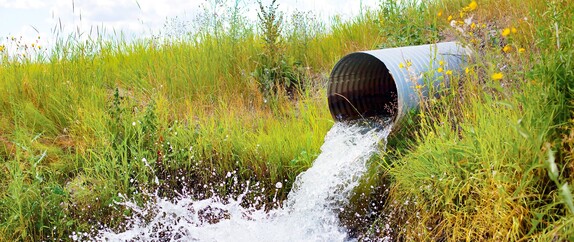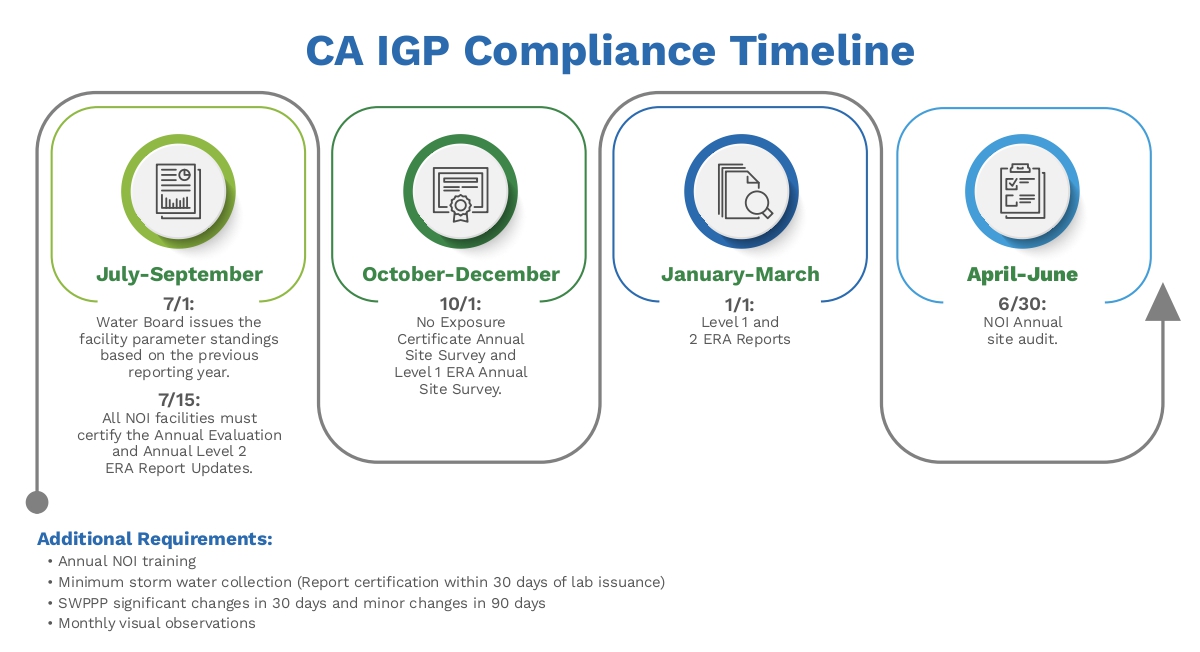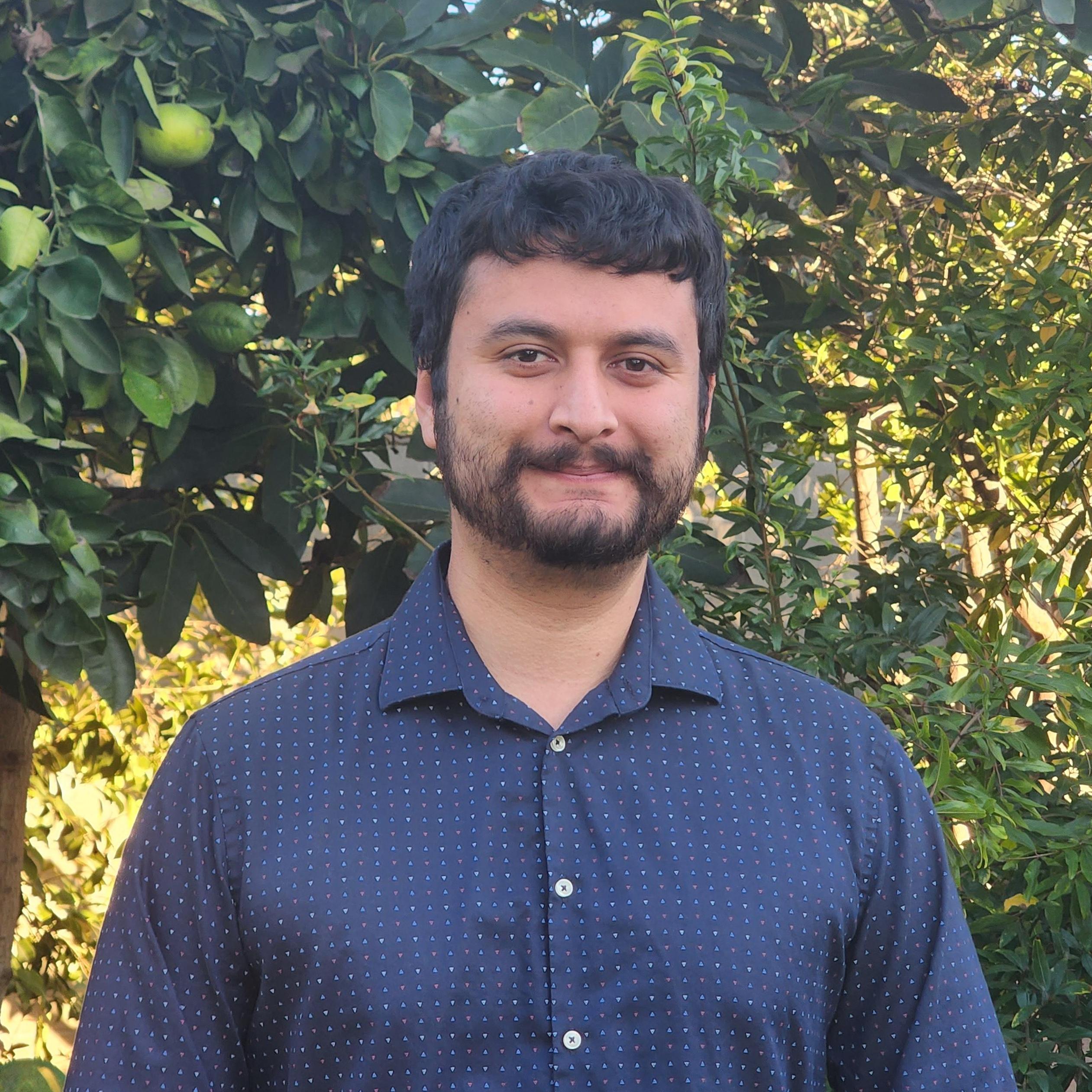
California Industrial General Permit:
Latest Regulatory Changes and Enforcement
September 16, 2024
By: Dasni Ahangama and Cesar Santana, QISP
A Background into the Latest Regulatory Changes and Enforcement
The California Industrial Stormwater Permit (CA IGP), also known as the General Permit, regulates the stormwater discharges and authorized non-stormwater discharges from point-source industrial facilities to minimize water pollution accumulation found in streams, rivers, lakes, and the ocean. Implementation and enforcement are conducted by the State Water Board and nine (9) Regional Water Quality Control Boards.
Effective July 1, 2020, under Order 2018-0028-DWQ, facilities located in San Francisco (Region 2), Los Angeles (Region 4), Santa Ana (Region 8), and San Diego (Region 9) may be subject to receiving waterbody quality-based standards. Facilities subject to the Notice of Intent (NOI) coverage in these regions must assess Total Maximum Daily Load (TMDL) applicability, amend their Stormwater Pollution Prevention Plan (SWPPP), and abide by the reporting requirements to avoid monetary fines.
The Regional Water Boards have been conducting audits specifically in the TMDL-impaired waterbody areas to ensure CA IGP permit holders are in compliance with the General Permit. Currently, the bulk of the reviews have been for exceedances and late reporting in the 2020-2021 reporting year, and facilities with deficiencies have been issued minimum mandatory penalties in the form of monetary fines. With recent updates and heightened enforcement, it’s crucial for industrial facilities to stay informed and compliant to protect water resources and avoid penalties and corrective actions.
Overview of the California Industrial General Permit
The CA General Permit provides coverage for many industrial facilities including manufacturers, landfills, mining, steam generating electricity, hazardous waste facilities, transportation with vehicle maintenance, larger sewage and wastewater plants, recycling facilities, and oil and gas facilities.
The three types of permit coverages under the IGP are as follows:
- Notice of Intent (NOI) – Industrial activity is exposed to stormwater and has the potential to discharge from the facility. Facilities under this coverage are required to maintain an up-to-date SWPPP, conduct annual training, perform sampling and submit results as Ad Hoc Reports, and conduct an annual evaluation.
- No Exposure Certification (NEC) – All industrial activities are conducted indoors or under cover, and the discharge leaving the property is not commingled with industrial activity. Facilities under this coverage are not required to sample or maintain a SWPPP.
- Notice of Non-Applicability (NONA) – A facility provides a “No Discharge Technical Report” to show the site can contain the maximum historic rain event, or series of precipitation events. This report must be signed by a California certified Professional Engineer (P.E.). Alternatively, a facility demonstrates the site is located in a basin or physical location that is not hydrologically connected to waters of the United States. Facilities under this coverage are not required to maintain a SWPPP.
Recent Regulatory Changes
Per the NOI requirements for the CA IGP, facilities may be subject to TMDLs established in the Regional Water Board Basin Plans (Basin Plans) and are the maximum pollutant loads from an identified source that a waterbody can receive while attaining water quality standards. Responsible Dischargers (i.e., facilities which discharge TMDL-specific pollutants based on operation and materials handling to an impaired receiving waterbody) must comply with TMDL-specific Numeric Action Levels (TNALs) and/or Numeric Effluent Limitations (NELs). Specific requirements are found in Table E-2 of the amended IGP.
- TNAL – Similar to existing technology-based Numeric Action Levels (NALs), exceedances of TNALs require implementation of Exceedance Response Actions (ERAs). Some parameters will have both NALs and TNALs and must be tracked concurrently. The implementation date for an impaired parameter can differ based on the waterbody. Failure to implement the required ERA process once a NAL or TNAL exceedance occurs constitutes a violation of the permit and can result in potential fines or third-party citizen lawsuits, similar to prior to this amendment.
- NEL– If a facility has a TMDL specific concentration-based limit, it becomes an NEL requirement. Currently, there are NELs in place in the Los Angeles, Santa Ana, and San Diego regions. Some parameters will have both NALs and NELs and must be tracked concurrently. An NEL exceedance occurs when two or more results in a reporting year exceed the NEL threshold for the parameter, for that specific sampling location. Further, an NEL exceedance will be an automatic violation of the CA IGP and subject to Water Quality Based Corrective Actions (WQBCA) and may result in an agency minimum fine of $3,000 per violation. A chronic violation occurs when a parameter exceeds an applicable NEL four or more times within a six-month period. A serious violation occurs when a parameter exceeds an applicable NEL by 40% or more, or 20% or more depending on the type of pollutant. Either type of violation will trigger a Notice of Violation from the Regional Board and result in a minimum fine of $3,000.
Enforcement and Compliance Strategies
In the past year, the TMDL changes in the San Francisco (Region 2), Los Angeles (Region 4), Santa Ana (Region 8), and San Diego (Region 9) regions have led to increased enforcement and consequently an increase in violations beginning with reporting year 2020-2021. This has also led to an increase in mandatory fines for facilities, not just the ones with TMDL sampling parameters. Below are common deficiencies facilities have been recently flagged by the Regional Water Boards.
- Ad Hoc reports certified greater than 30 days from lab report issuance date. For example, if the sample was collected on 10/25 and the lab issues the report on 11/15, then the Ad Hoc report must be certified (not just uploaded) on SMARTS by 12/15. Potential for penalties begin on 1/14. This means for every 30-day period after 12/15, a minimum fee of $3,000 is issued. To avoid such penalties, certify Ad Hoc reports within 30 days of lab issuance.
- Facilities trigger an NEL exceedance due to sample results. The Water Board has been auditing Ad hoc reports for NEL exceedances beginning with 2020 and issuing mandatory minimum penalties of $3,000 per violation and requesting a WQBCA report. The WQBCA requires a facility evaluation to identify pollutant sources, current BMP implementation, and provide best management techniques to reduce the pollutant levels for the TMDL parameter. This report must be certified within 30 days of the letter from the Water Board and must include additional BMPs and/or SWPPP implementation measures that have been identified and included in the SWPPP. To avoid NEL exceedances, applicable facilities should ensure all BMPs are correctly implemented and maintained, the pollution prevention team is trained annually, and consult a QISP for advanced BMPs including on/off-site compliance options.
- In California, the SWPPP is a live document where significant changes (i.e. TMDL regulatory changes) need to be updated in 30 days and minor changes need to update in 90 days. The Water Board may also deem a SWPPP deficient if any component in the IGP Appendix A checklist is missing, or not clearly stated in the SWPPP. If a facility SWPPP has not been reviewed since 2020 or after major changes to a facility, there is an increased risk of the Water Board issuing a violation. In most cases, the facility is given 30 days to comply with the request, and a facility may be subject to monetary fines. It is recommended during the annual evaluation that the facilities assess whether a SWPPP update is needed.
- Failing to keep five (5) years’ worth of records readily available onsite. All Pollution Prevention Team members are responsible for maintaining the facility records. Records can be either kept online or hard-copy as long as it is available upon request by the Water Board during operational hours.
The best practices for maintaining compliance with the CA IGP is to ensure the facility SWPPP is up to date, all fees have been paid, all records for the past 5 years are readily available, conduct annual training, collect good samples, and ensure the facility certifies reports in a timely manner. Below is the general CA IGP compliance timeline.

Impact on Water Resources
Maintaining the requirements of the CA IGP, with the updated SWPPP and compliant samples, can reduce the risk of monetary violations and reduce the facilities’ requirement to collect stormwater samples, and thereby reducing the overall costs associated with the stormwater program. In safeguarding the water resources by having less water pollution leaving point-source facilities, this diminishes the risk of pollutant builds up downstream that impacts infrastructure, recreational activities, and biodiversity.
Resources and Next Steps
For additional resources on the California Industrial General Permit please see the links below.
- California Industrial General Permit
- List of Existing TMDLs Applicable to Industrial Facilities
- 2018 Industrial Stormwater General Permit Amendment
- Industrial Stormwater General Permit Map Tool
Conclusion
Staying informed and compliant with the CA IGP is more important than ever. By understanding the recent regulatory changes and taking proactive measures, industrial facilities can not only avoid penalties but also play a vital role in protecting California’s precious water resources.
For expert guidance on navigating the complexities of the California Industrial General Permit, contact us today. Our team of water resource specialists, including Qualified Industrial Stormwater Practitioners (QISPs), are here to help you stay compliant and protect our environment and industrial facility needs.
 Dasni Ahangama
Dasni Ahangama
Project Scientist
Dasni Ahangama brings over 6 years of industry experience to the Montrose team, where she currently serves as a Project Scientist II. She specializes in air quality and stormwater permitting and compliance, with a focus in Southern California. In addition, Ms. Ahangama has experience with municipal Land Management Systems and urban planning. She holds a Master’s in Urban and Regional Planning and B.S. in Earth Systems Science with a minor in Global Sustainability.
 Cesar Santana, QISP
Cesar Santana, QISP
Project Engineer
Cesar Santana is a dedicated Project Engineer at Montrose Environmental Group, where he has been making significant contributions since November 2023. With a strong background in environmental engineering, Cesar brings over four years of experience in stormwater management and water quality data analysis to his current role. Before joining Montrose, Cesar served as the Engineering Manager at Frog Environmental in the Greater Los Angeles Area. During his tenure from September 2019 to April 2024, he successfully managed and coordinated Southern California stormwater sampling programs, including Riverside and San Diego. Beyond the sampling program, Cesar also managed clients in the Central Coast, Bay Area, and Napa & Sonoma counties. He developed Exceedance Response Action reports and oversaw the implementation of TMDL-based requirements for facilities’ compliance programs, ensuring adherence to environmental regulations.

